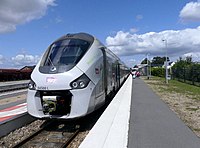
Photo from wikipedia
Abstract Economic and environmental disadvantages of conventional cutting fluids based on mineral oil drive the research for alternative methods such as dry cutting, cutting with alternative cutting fluids and/or minimum… Click to show full abstract
Abstract Economic and environmental disadvantages of conventional cutting fluids based on mineral oil drive the research for alternative methods such as dry cutting, cutting with alternative cutting fluids and/or minimum quantity lubrication. Oil-in-air minimum quantity lubrication is a frequently discussed method in literature. However, this technique only provides lubrication without sufficient cooling and is therefore often combined with cryogenic fluids such as liquid nitrogen. In recent research, the use of minimum quantity lubrication combined with supercritical carbon dioxide is used. The researches focus on processes with geometrically defined cutting edges. The relevant literature can therefore not describe the use of minimum quantity lubrication combined with supercritical carbon dioxide in cutting-fluid-intense processes such as grinding. Regarding this research gap, a conducted feasibility study is presented in this paper as first approach to understand the potentials and barriers using supercritical carbon dioxide in surface grinding processes. In a novel MQL-scCO2 grinding application, the research includes the evaluation of a nozzle application, grinding forces, roughnesses, cutting power and the grinding wheel clogging using supercritical carbon dioxide in grinding. It was found that the use of supercritical carbon dioxide in combination with minimum quantity lubrication overall leads to lower or similar forces and cutting power compared to conventional cooling lubrication with emulsion. It was also determined that, in its current state of development, the surface roughness increases. Hence further research is needed, specifically in the topics of an optimized nozzle construction, thermal analysis and dressing characteristics. A simplified evaluation of energy performance indicators shows a potential to cleaner production compared to a conventional system.
Journal Title: Journal of Cleaner Production
Year Published: 2021
Link to full text (if available)
Share on Social Media: Sign Up to like & get
recommendations!